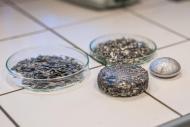Ideas and discoveries
Recycling solar panels? No yet existent. NEW technology from BUT offers a solution

Silver, silicon, tin and zinc. Wafers from decommissioned solar panels contain various metals that would be useful to separate or alternatively utilise in new alloys. Until now, however, there has been no technology allowing for their ecological and economic recycling. Researchers from the Materials Research Centre (MRC) of the Faculty of Chemistry at the BUT now offer a solution.
The number of solar panels in the warehouses of recycling companies is increasing – according to data from VIA ALTA, it is currently necessary to dispose of 3–4 tons of them daily in the Czech Republic. The number will significantly increase, as the solar panel boom started in 2010, and their typical lifespan, depending on the chosen technology, ranges from 10 to 25 years.
The problem is faced not only by the Czech Republic but also by other European countries. Therefore, chemists from MRC BUT were given a challenging task by experts from VIA ALTA – to devise a utility model of technology that would allow processing tons of waste environmentally and profitably.
"Manufacturing companies usually claim that their solar panels are perfectly recyclable. It’s not true. The panels are approximately 90% recycled, as required by legislation – massive glass and aluminium frames that hold the structure together are removed. However, a smaller conductive part called a wafer, embedded in polymer, remains. It contains silver and other interesting metals," the project leader Jaromír Wasserbauer from the Laboratory of Metals and Corrosion at MRC BUT explains.
The researchers had to abandon their original intention of separating individual metals during the three-year research. "Incineration is an ecological disaster due to the fluorinated polymers used. Therefore, we tested a chemical route that is perfect for separating metals in mobile phones containing gold elements," Matěj Březina, head of the research department, explains.
They placed the polymer from the solar panel into a solvent and successfully extracted the individual metals. However, the process was not only slow but also expensive. "Silver is several times cheaper than gold, and solar panels contain only a trace of it, which does not retroactively pay for recycling technology," Březina calculates the dead ends they encountered during the project.
In the end, researchers opted for the opposite strategy – not to separate metals from the material but to add shavings from machined aluminium to the crushed wafer.
They poured two types of waste from different sources into aluminium ingots, which can be used in foundry production. "We realised that all metals contained in the wafers can be used to improve the properties of aluminium alloys. Foundry companies melt the ingots in the right ratio with aluminium and can manufacture," Wasserbauer concludes. A piece of a retired solar panel can thus become, for example, a new engine block or gearbox.
Currently, researchers from MRC BUT want to explore recycling technologies for other types of solar panels. The new solar panels no longer contain silver, but a variety of other interesting elements – such as copper, indium, gallium, selenium, sulphur, zinc and cadmium.
The research project was created thanks to the support of TA CR in the TREND 1 programme.
(mar)
Cheaper, better quality and eco-friendly. FCH BUT researchers create new dextrin adhesive
Cement production can be cheaper and more ecological thank to the recipe from FCH BUT
From Prosecco to Bioplastics: An Italian Scientist's Journey to Sustainable Innovations
Nilmore's circular clothing allows you to use the fibre repeatedly
They were looking for a way how to supress the negative effect of zinc on cement. They developed a material with even better properties
